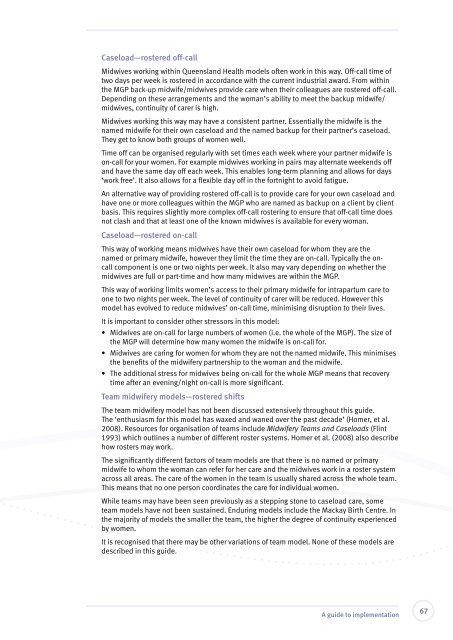Delivering continuity of midwifery care to Queensland women
Delivering continuity of midwifery care to Queensland women
Delivering continuity of midwifery care to Queensland women
You also want an ePaper? Increase the reach of your titles
YUMPU automatically turns print PDFs into web optimized ePapers that Google loves.
Caseload—rostered <strong>of</strong>f-call<br />
Midwives working within <strong>Queensland</strong> Health models <strong>of</strong>ten work in this way. Off-call time <strong>of</strong><br />
two days per week is rostered in accordance with the current industrial award. From within<br />
the MGP back-up midwife/midwives provide <strong>care</strong> when their colleagues are rostered <strong>of</strong>f-call.<br />
Depending on these arrangements and the woman’s ability <strong>to</strong> meet the backup midwife/<br />
midwives, <strong>continuity</strong> <strong>of</strong> <strong>care</strong>r is high.<br />
Midwives working this way may have a consistent partner. Essentially the midwife is the<br />
named midwife for their own caseload and the named backup for their partner’s caseload.<br />
They get <strong>to</strong> know both groups <strong>of</strong> <strong>women</strong> well.<br />
Time <strong>of</strong>f can be organised regularly with set times each week where your partner midwife is<br />
on-call for your <strong>women</strong>. For example midwives working in pairs may alternate weekends <strong>of</strong>f<br />
and have the same day <strong>of</strong>f each week. This enables long-term planning and allows for days<br />
‘work free’. It also allows for a flexible day <strong>of</strong>f in the fortnight <strong>to</strong> avoid fatigue.<br />
An alternative way <strong>of</strong> providing rostered <strong>of</strong>f-call is <strong>to</strong> provide <strong>care</strong> for your own caseload and<br />
have one or more colleagues within the MGP who are named as backup on a client by client<br />
basis. This requires slightly more complex <strong>of</strong>f-call rostering <strong>to</strong> ensure that <strong>of</strong>f-call time does<br />
not clash and that at least one <strong>of</strong> the known midwives is available for every woman.<br />
Caseload—rostered on-call<br />
This way <strong>of</strong> working means midwives have their own caseload for whom they are the<br />
named or primary midwife, however they limit the time they are on-call. Typically the oncall<br />
component is one or two nights per week. It also may vary depending on whether the<br />
midwives are full or part-time and how many midwives are within the MGP.<br />
This way <strong>of</strong> working limits <strong>women</strong>’s access <strong>to</strong> their primary midwife for intrapartum <strong>care</strong> <strong>to</strong><br />
one <strong>to</strong> two nights per week. The level <strong>of</strong> <strong>continuity</strong> <strong>of</strong> <strong>care</strong>r will be reduced. However this<br />
model has evolved <strong>to</strong> reduce midwives’ on-call time, minimising disruption <strong>to</strong> their lives.<br />
It is important <strong>to</strong> consider other stressors in this model:<br />
• Midwives are on-call for large numbers <strong>of</strong> <strong>women</strong> (i.e. the whole <strong>of</strong> the MGP). The size <strong>of</strong><br />
the MGP will determine how many <strong>women</strong> the midwife is on-call for.<br />
• Midwives are caring for <strong>women</strong> for whom they are not the named midwife. This minimises<br />
the benefits <strong>of</strong> the <strong>midwifery</strong> partnership <strong>to</strong> the woman and the midwife.<br />
• The additional stress for midwives being on-call for the whole MGP means that recovery<br />
time after an evening/night on-call is more significant.<br />
Team <strong>midwifery</strong> models—rostered shifts<br />
The team <strong>midwifery</strong> model has not been discussed extensively throughout this guide.<br />
The ‘enthusiasm for this model has waxed and waned over the past decade’ (Homer, et al.<br />
2008). Resources for organisation <strong>of</strong> teams include Midwifery Teams and Caseloads (Flint<br />
1993) which outlines a number <strong>of</strong> different roster systems. Homer et al. (2008) also describe<br />
how rosters may work.<br />
The significantly different fac<strong>to</strong>rs <strong>of</strong> team models are that there is no named or primary<br />
midwife <strong>to</strong> whom the woman can refer for her <strong>care</strong> and the midwives work in a roster system<br />
across all areas. The <strong>care</strong> <strong>of</strong> the <strong>women</strong> in the team is usually shared across the whole team.<br />
This means that no one person coordinates the <strong>care</strong> for individual <strong>women</strong>.<br />
While teams may have been seen previously as a stepping s<strong>to</strong>ne <strong>to</strong> caseload <strong>care</strong>, some<br />
team models have not been sustained. Enduring models include the Mackay Birth Centre. In<br />
the majority <strong>of</strong> models the smaller the team, the higher the degree <strong>of</strong> <strong>continuity</strong> experienced<br />
by <strong>women</strong>.<br />
It is recognised that there may be other variations <strong>of</strong> team model. None <strong>of</strong> these models are<br />
described in this guide.<br />
A guide <strong>to</strong> implementation<br />
67
















